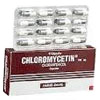Latest Blog Posts:
Get Updates & Coupons
Drug: Chloromycetin
Chloromycetin, also referred to as Chloramphenicol, is a strong antibiotic that is vital in treating various types of bacterial infections. In order to ensure effective and safe treatment, this provides an essential guide on the uses, side effects, and dosage recommendations.
What is Chloromycetin?
Chloromycetin acts as an antibacterial drug in the body. It helps to get rid of serious infections that are caused by bacteria resistant to other antibiotics. The medicine operates by preventing bacteria from growing thus wiping out the infection from the body.
Chloromycetin Uses
Circumstances where other antibiotics fail to manage the infection effectively call for the use of chloromycetin which treats varied types of infections such as meningitis, typhoid fever and eye infections among others.
Chloromycetin Side Effects
In addition to its action against bacterial infection, there are certain side effects associated with Chloramphenicol therapy. Nausea, vomiting, diarrhea and slight rash are common unwanted effects of this medication. Also bone marrow suppression can possibly occur leading to anaemia and other blood related issues that may be severe. In case one experiences severe side effects it is advisable to immediately consult a healthcare provider.
Chloromycetin Dosage
The dosage of chloromycetin will vary depending on the type and severity of infection, age and overall health status of the patient. Ensuring proper treatment effectiveness while minimizing side effect risks require observance of recommended dosages from your doctor.
Adult Dosage
The usual dose is 50 to 100 mg/kg/day given in four divided doses for adults. The duration of treatment depends on the type of infection and response to the drug.
Children's Dosage
In children, the dosage is determined based on weight, with a general guideline of 50 to 100 mg/kg/day, divided into four doses. The duration of treatment varies depending on the specific infection and how well it responds to this treatment as an adult would.
Precautions and Warnings
Prior liver or kidney problems have been associated with chloromycetin use which should therefore be used cautiously by such patients and those who have a history of blood disorders. Assessments at regular intervals during treatment are necessary for determining if there has been any changes in blood levels, kidney or liver functioning.
Conclusion
Chloromycetin is a powerful antibiotic that treats resistant bacterial infections. To increase efficiency in therapy and reduce possible risks one should know what it actually treats, side effects and correct dosage. Before starting to take another drug consult health care professional who will advise you whether this medication suits your condition or not.




